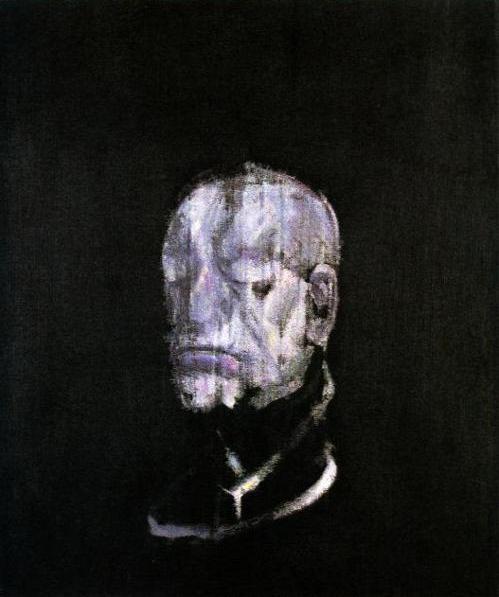Francis Bacon Gallery
Subject: William Blake (1757- 1827), author of The Marriage of Heaven and Hell, engraver of The Ancient of Days. By his old age, when he had his life-mask taken, Blake was a cult figure among a small circle of Romantics. In September 1823, he let the sculptor James Deville immerse his head in plaster, with only a straw to breath through as it solidified.
Before photography, masks from moulds of living and recently dead faces were the most accurate way of preserving someone's appearance. Deville probably learned the technique from his master, the sculptor Joseph Nollekens. Deville practised phrenology - reading character from the size and shape of the skull, as devised by J Spurzheim. Blake seems to have read Spurzheim, too. His drawing of the man who taught him painting in his dreams (c1819-20) resembles a phrenology diagram. Deville built up a collection of casts and wished to include Blake's "as representative of the imaginative faculty". Because of phrenology, we have a quasi-photographic image of an artist who has become infinitely more famous since his death.
Distinguishing features: Blake is a pale film in the dark, a flayed face, features compressed like those of a bank robber with a stocking over his head. The features are brutally crushed, there and not there, eyes pressed shut, one eyebrow oddly raised, the lips pushed in. Although skin is vividly suggested in the sickening pink of the brow and cheek, this is not the outward man. White mist flows up the cheek and over the broad skull, dematerialising the flesh. It's as if we are looking underneath the surface of skin at the ghostly presence of the man within. This is a portrait not of the flesh, but of the spirit.
Bacon made a series of paintings of Blake's life-mask in the mid-1950s. The title, however, is generalised: "Study for Portrait" suggests this is an attempt to get at the essence of what a portrait is.
Bacon kept his own copy of Blake's life-mask next to treasured personal photographs. His painting feels as if it were based on a photograph. Bacon stresses the similarity of life-casting to photography, in order to reveal the deathliness and violence of both in rendering brute fact. His painting, however, apprehends something beneath the visible skin: an inner self, suffering in absolute isolation.
This is a passionate and finally mysterious tribute from one great London artist to another.
Inspirations and influences: There are models for this intense communion with a dead artist in Blake's work. Blake portrayed, from life, the spirits who visited him. Blake's spirit portraits include John Milton, and The Ghost of a Flea (c1819-20). There's a similarity between Bacon's Blake and Blake's Flea in their fleshy, monstrous intensity, the authority of a vision seen in darkness.
Where is it? Tate Britain, London SW1 (020-7887 8008).
Extract from The Guardian UK

viewer |
|
|
| Self-portrait |
| Portrait |
Blake |
| Pope Innocent |
| Portrait2 |
| Mirror |
| Van Gogh |
| Lucian Freud |
Biography
Bulletin Board
Renowned Art
(home)
Francis Bacon was born in Dublin, Ireland to English parents. He was expelled from his family in 1925 when his homosexuality was discovered. Bacon never attended art school. He began work in watercolor about 1926–27 and oils in the fall of 1929. Bacon painted relatively little after his solo show in 1934. He was often disdainful of his work destroyed large number of works throughout his lifetime. Representative of Bacon's methods and subjects are the triptych, the scream, and the lone figure against a stark backgroud.
all artists, with thumbnails: by birth year | alphabetically
all artists: by birth year | alphabetically
artists born in the 13th 14th 15th 16th 17th 18th 19th 20th century